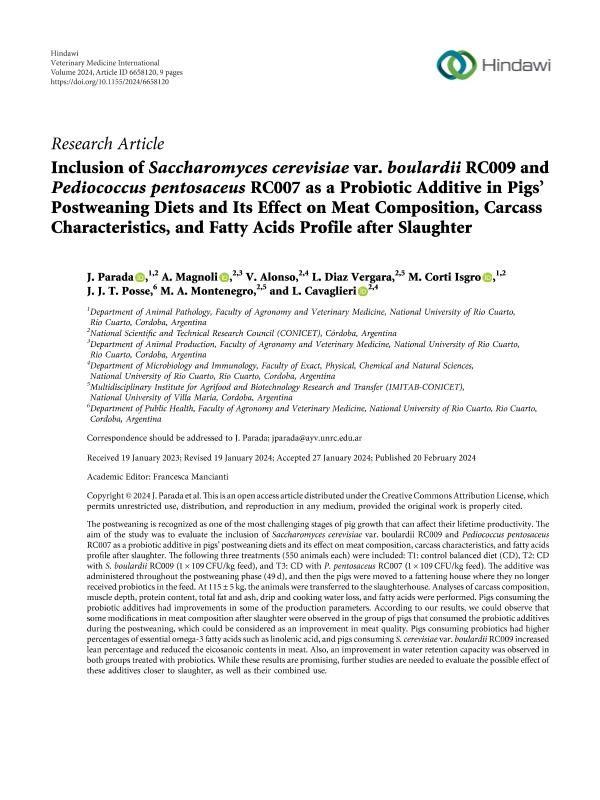Artículo
Inclusion of Saccharomyces cerevisiae var. boulardii RC009 and Pediococcus pentosaceus RC007 as a Probiotic Additive in Pigs’ Postweaning Diets and Its Effect on Meat Composition, Carcass Characteristics, and Fatty Acids Profile after Slaughter
Parada, Julian ; Magnoli, Alejandra Paola
; Magnoli, Alejandra Paola ; Alonso, Veronica Andrea
; Alonso, Veronica Andrea ; Diaz Vergara, Ladislao Ivan
; Diaz Vergara, Ladislao Ivan ; Corti Isgro, Maite
; Corti Isgro, Maite ; Posse, J. J. T.; Montenegro, Mariana Angélica
; Posse, J. J. T.; Montenegro, Mariana Angélica ; Cavaglieri, Lilia Reneé
; Cavaglieri, Lilia Reneé
 ; Magnoli, Alejandra Paola
; Magnoli, Alejandra Paola ; Alonso, Veronica Andrea
; Alonso, Veronica Andrea ; Diaz Vergara, Ladislao Ivan
; Diaz Vergara, Ladislao Ivan ; Corti Isgro, Maite
; Corti Isgro, Maite ; Posse, J. J. T.; Montenegro, Mariana Angélica
; Posse, J. J. T.; Montenegro, Mariana Angélica ; Cavaglieri, Lilia Reneé
; Cavaglieri, Lilia Reneé
Fecha de publicación:
02/2024
Editorial:
Hindawi Publishing Corporation
Revista:
Veterinary Medicine International
ISSN:
2090-8113
Idioma:
Inglés
Tipo de recurso:
Artículo publicado
Clasificación temática:
Resumen
The postweaning is recognized as one of the most challenging stages of pig growth that can affect their lifetime productivity. The aim of the study was to evaluate the inclusion of Saccharomyces cerevisiae var. boulardii RC009 and Pediococcus pentosaceus RC007 as a probiotic additive in pigs’ postweaning diets and its effect on meat composition, carcass characteristics, and fatty acids profile after slaughter. The following three treatments (550 animals each) were included: T1: control balanced diet (CD), T2: CD with S. boulardii RC009 (1 × 109 CFU/kg feed), and T3: CD with P. pentosaceus RC007 (1 × 109 CFU/kg feed). The additive was administered throughout the postweaning phase (49 d), and then the pigs were moved to a fattening house where they no longer received probiotics in the feed. At 115 ± 5 kg, the animals were transferred to the slaughterhouse. Analyses of carcass composition, muscle depth, protein content, total fat and ash, drip and cooking water loss, and fatty acids were performed. Pigs consuming the probiotic additives had improvements in some of the production parameters. According to our results, we could observe that some modifications in meat composition after slaughter were observed in the group of pigs that consumed the probiotic additives during the postweaning, which could be considered as an improvement in meat quality. Pigs consuming probiotics had higher percentages of essential omega-3 fatty acids such as linolenic acid, and pigs consuming S. cerevisiae var. boulardii RC009 increased lean percentage and reduced the eicosanoic contents in meat. Also, an improvement in water retention capacity was observed in both groups treated with probiotics. While these results are promising, further studies are needed to evaluate the possible effect of these additives closer to slaughter, as well as their combined use.
Palabras clave:
MEAT
,
PROBIOTIC
,
PIGS
,
PRODUCTIVE PARAMETERS
Archivos asociados
Licencia
Identificadores
Colecciones
Articulos (IMITAB)
Articulos de INSTITUTO MULTIDISCIPLINARIO DE INVESTIGACIÓN Y TRANSFERENCIA AGROALIMENTARIA Y BIOTECNOLÓGICA
Articulos de INSTITUTO MULTIDISCIPLINARIO DE INVESTIGACIÓN Y TRANSFERENCIA AGROALIMENTARIA Y BIOTECNOLÓGICA
Articulos(CCT - CORDOBA)
Articulos de CTRO.CIENTIFICO TECNOL.CONICET - CORDOBA
Articulos de CTRO.CIENTIFICO TECNOL.CONICET - CORDOBA
Citación
Parada, Julian; Magnoli, Alejandra Paola; Alonso, Veronica Andrea; Diaz Vergara, Ladislao Ivan; Corti Isgro, Maite; et al.; Inclusion of Saccharomyces cerevisiae var. boulardii RC009 and Pediococcus pentosaceus RC007 as a Probiotic Additive in Pigs’ Postweaning Diets and Its Effect on Meat Composition, Carcass Characteristics, and Fatty Acids Profile after Slaughter; Hindawi Publishing Corporation; Veterinary Medicine International; 2024; 6658120; 2-2024; 1-9
Compartir
Altmétricas



